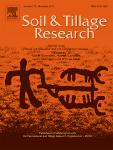Ver ítem
- xmlui.general.dspace_homeCentros Regionales y EEAsCentro Regional Entre RíosEEA ParanáArtículos científicosxmlui.ArtifactBrowser.ItemViewer.trail
- Inicio
- Centros Regionales y EEAs
- Centro Regional Entre Ríos
- EEA Paraná
- Artículos científicos
- Ver ítem
Developments in the “profil cultural” method for an improved assessment of soil structure under no-till
Resumen
In France, agronomists have studied the effects of cropping systems on soil structure using a field method that is based on a visual description of the soil structure. This “profil cultural” method was designed as a field diagnostic tool to identify the effects of tillage and compaction on soil structure dynamics. It is of great benefit to agronomists seeking to improve crop management and preserve soil structure and fertility. However, the “profil
[ver mas...]
In France, agronomists have studied the effects of cropping systems on soil structure using a field method that is based on a visual description of the soil structure. This “profil cultural” method was designed as a field diagnostic tool to identify the effects of tillage and compaction on soil structure dynamics. It is of great benefit to agronomists seeking to improve crop management and preserve soil structure and fertility. However, the “profil cultural” method was developed and has mainly been used in conventional tillage systems with regular ploughing. As there has been an increase in the use of various forms of reduced, minimum and no-tillage systems in many parts of the world, it is necessary to re-evaluate this method’s ability to describe and interpret soil structure dynamics in no-till or reduced tillage. In these situations, changes in soil structure over time are mainly driven by compaction and by regeneration through natural agents (climatic conditions, root growth and macrofauna), therefore it is important to evaluate the effects of these natural processes on soil structure dynamics. These concerns have led to adaptations and amendments to the initial method based on field observations and experimental work in different cropping systems, soil types and climatic conditions. The description of crack types has been improved and a criterion of biological activity based on the visual examination of clods has been introduced. To test this modified method, a comparison with the initial method was undertaken and its ability to make diagnoses tested in five experiments in France, Brazil and Argentina. The adapted method allowed an improved assessment of the impact of cropping systems on soil functioning when natural processes were integrated into the description.
[Cerrar]

Autor
Boizard, Hubert;
Peigné, Joséphine;
Sasal, Maria Carolina;
Guimarães, Maria De Fátima;
Piron, Denis;
Tomis, Vincent;
Vian, Jean-François;
Cadoux, Stéphane;
Ralisch, Ricardo;
Tavares Filho, João;
Heddadj, Djilali;
De Battista, Juan Jose;
Duparque, Annie;
Franchini, Julio Cezar;
Roger-Estrade, Jean;
Fuente
Soil and Tillage Research 173 : 92-103 (November 2017)
Fecha
2017-11
Editorial
Elsevier
ISSN
0167-1987
1879-3444
1879-3444
Formato
pdf
Tipo de documento
artículo
Palabras Claves
Derechos de acceso
Restringido
 Excepto donde se diga explicitamente, este item se publica bajo la siguiente descripción: Creative Commons Attribution-NonCommercial-ShareAlike 2.5 Unported (CC BY-NC-SA 2.5)
Excepto donde se diga explicitamente, este item se publica bajo la siguiente descripción: Creative Commons Attribution-NonCommercial-ShareAlike 2.5 Unported (CC BY-NC-SA 2.5)

